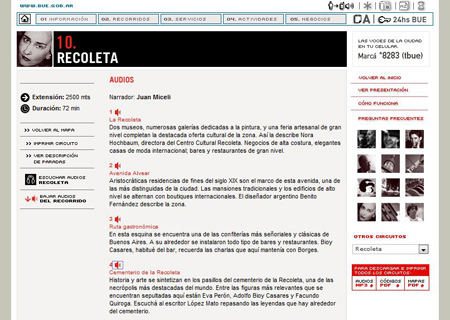
How a city chooses to promote tourism often reflects its own self-image. After the 2001 economic crisis & following devaluation, Buenos Aires became a very popular destination: exotic & affordable. Naturally, the city government jumped on the tourism bandwagon & developed an extensive website to provide information about Buenos Aires to visitors. In our opinion, they did a spectacular job in a short period of time.
The website included a series of audiotours available for download, one in particular focusing on the neighborhood of Recoleta. Although basic, it introduces visitors to the general layout of the area. As for the cemetery, no separate audiotour was available… but three minutes (of that 72-minute recording) are dedicated to the most popular attraction in Buenos Aires. Text on the webpage describes the site:
Historia y arte se sintetizan en los pasillos del cementerio de la Recoleta, una de las necrópolis más destacadas del mundo. Entre las figuras más relevantes que se encuentran sepultadas aquí están Eva Perón, Adolfo Bioy Casares y Facundo Quiroga. Escuchá al escritor López Mato repasando las leyendas que hay alrededor del cementerio.
History & art are summed up in the passageways of Recoleta Cemetery, one of the most notable necropoles in the world. Among the most relevant figures buried here are Eva Perón, Adolfo Bioy Casares, & Facundo Quiroga. Listen to author López Mato recount stories about the cemetery.
Spanish speakers can listen to the three-minute segment below. Strangely, the text above lists Bioy Casares & Quiroga as noteworthy, but they are not mentioned in the audio… a minor oversight but Sarmiento would be better to highlight than Quiroga:
For non-Spanish speakers: According to the audioguide, the most important people in Argentine history are buried in Recoleta Cemetery. No doubt. Its architecture is important & over 70 tombs have been declared National Historic Monuments. Good so far. Omar López Mato discusses the meaning behind the dates inscribed on the floor of the main entrance. Not so important but fine to mention. Eva Perón is here, important for her social work & fight for women’s right to vote. Then López Mato tells the urban legend surrounding Rufina Cambacérès. What’s a cemetery without a few urban legends?
However… No mention is made about restoration works in progress. There is no discussion about the origins of the cemetery. And probably the worst omission is that no effort is made to convey a sense of all the historical sagas contained within its walls.
Like no other cemetery in the world, Recoleta wraps up almost 200 years of national drama… Rosas, Lavalle & Dorrego all wound up in the same place. Juárez Celman, Roca, Pellegrini, Alem, & Campos are all neighbors (well, JC has since been moved). Aramburu, Lonardi, & Evita rest in peace together. I doubt they ever thought they would all end up in the same spot. Anyone who knows minimal Argentine history cannot ignore the irony of that.
A visit to Recoleta Cemetery should remind visitors that the same fate awaits us all —friends & enemies alike— & turn that observation into a lesson about Argentine history. It’s a twist that few tour guides or authors emphasize & doing so would present a more complete image of the city & the nation.
Be First to Comment